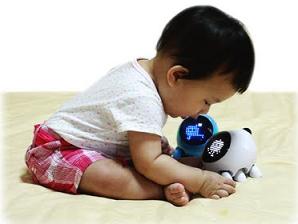
In the late 90s, the digital pets craze swept playgrounds and classrooms throughout Japan and the US. The amazingly popular Tamagotchi let you ‘raise’ a virtual pet by attending to its constant needs through pressing buttons on a small egg-shaped toy key chain. Like all fads, the digital pets craze faded, but not completely. Between 1996 and 2008, over 70 million Tamagotchis were sold. Now, I fear it may return stronger than ever. Witness the U.bo, a small robot from Phison. The baseball sized bot contains a virtual pet, a little alien creature, that you can see via a 11×11 LED screen. Shake, spank, and love the U.bo and it will reward you with smiles, kisses, dances…and poop. If you get tired of interacting with it via its robotic shell, you can hook the digital pet up to your PC and play with it in a virtual reality setting. The U.bo drew a constant crowd of impressionable kids during this summer’s Tokyo Toy Show. Watch the digital pet fawn over the attention it receives in the videos below. Our children are not safe from these cutesy aliens that desire our ‘wuv’.
Shortly after and coinciding with the Tamagotchi craze came the arrival of the Furby, a robot pet that could interact with its owners via speech. There also arose completely virtual pets that you raise via computer games and websites – the popular Nintendogs series is a notable recent example. There’s been an almost constant flood of robot and virtual pets since the late 90s, but U.bo is aiming to bring all the disparate digital pet innovations into one platform. It moves in the physical world, interacts with other U.bos, it has a virtual version, and most of all, it craves the attention and interaction with its owner. It has its bases covered.
U.bo at the Tokyo Toy Show:
U.bo in the Magic Land virtual realm:
Why should we care about the digital pets version of crack cocaine? Most robots are toys. IEEE Spectrum wrote a great article earlier this year about the world population of robots surpassing 8 million. But those were service and industry devices. The Furby sold 40 million units in just three years! The world of toys is where simple robotic features and capabilities get tested in huge numbers. Toy robots are shaped by the harshest form of feedback in the world – retail sales.
U.bo looks pretty simple, and compared to service and industrial robots it certainly is such. Yet it is striving to engage humans on an emotional level, to develop a simple character that humans grow to care about. That human-robot connection isn’t a trivial thing. Sure, we probably don’t want the robots of the future to make farting sounds and require us to shake them to clean up their poop (one of U.bo’s more pleasant features), but we may want them to desire our love. How else will we trust, control, or teach them when they surpass the human brain in reasoning skill? Looking at the U.bo I see more than a devious attempt to consume all my free time and disposable income, I see a sort of experiment in human-machine interactions. Somewhere in our process of developing robot toys we are likely to shape the individual attitudes, cultural bias, and consumer expectations that will effect the ground-breaking advances in robotics we may see in the decades ahead. Try to keep that in mind as you watch them dance like idiots:
[image and video credits: Robovation Phison]
[source: U.bo website]


